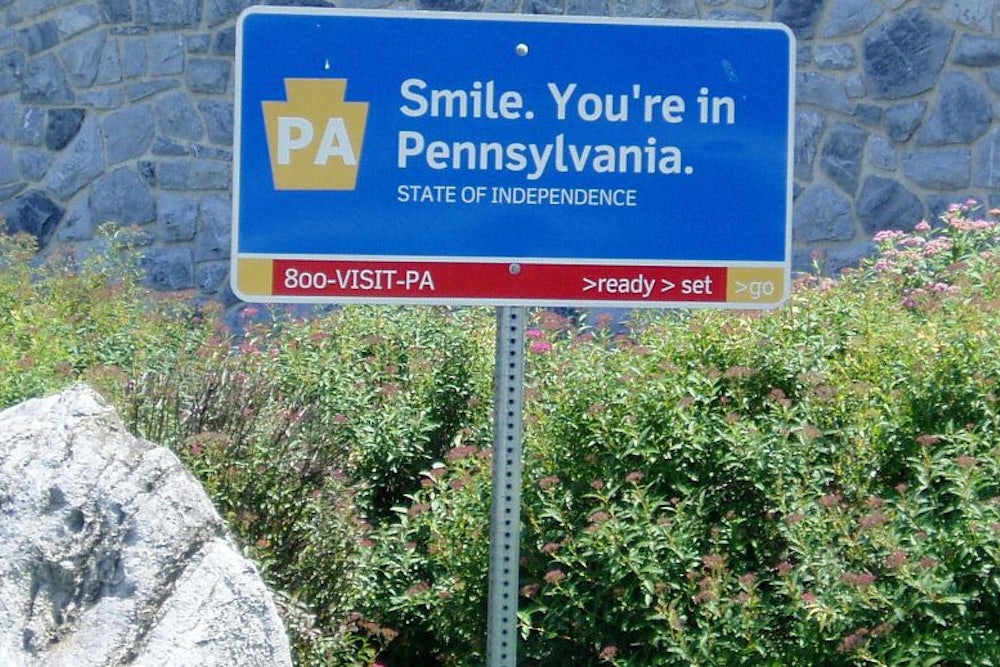Pennsylvania was all but ignored in 2012, but the Keystone State is poised to return to prominence in 2016. On Tuesday, Joe Sestak, a former Democratic congressman, indicated his interest in a rematch with Republican Senator Pat Toomey in 2016. And the 2012 presidential election results no doubt have attracted the attention of Republican strategists, since Pennsylvania voted for President Barack Obama by just 5.4 points—as much as Colorado and less than Obama’s wider victories in battlegrounds like Iowa, New Hampshire, Wisconsin, and Nevada. That margin is partly why Amy Walter of the Cook Political Report believes that Pennsylvania is a "GOP keystone," representing “the biggest promise” for the party in 2016. I disagree. While the next Republican candidate should campaign in Pennsylvania, winning the state's 20 electoral votes will be tough—probably tougher than any battleground state, save Nevada.
Pennsylvania’s always close, but it has been blue in six consecutive presidential elections. Walter’s math highlights why that streak could continue. From Walter’s perspective, the GOP needs “just” 45 percent in the Philadelphia media market, but that’s not going to happen—not without a decisive Republican victory. The city proper, which comprises about 35 percent of the Philadelphia media market and is a well-oiled Democratic machine, gave Obama 85 percent of the vote last November. In 2010, Democratic gubernatorial and senate candidates received 83 and 84 percent of Philadelphia, even while losing statewide.
If Republicans want to win 45 percent of the Philadelphia media market, they’ll need about 60 percent in the Philadelphia suburbs. That’s not happening, either. The last Republican to come close was Senator Arlen Specter, a pro-choice, long-time incumbent who only received 56 percent of the two-party vote in the Philly burbs in an uncompetitive 2004 contest.
Pennsylvania is a diverse state—too diverse for the GOP to win by making narrow, concentrated gains among any single demographic group or region. Toomey and Governor Tom Corbett didn’t approach Walter’s benchmark in the Philadelphia media market, but they won with broad gains across the state. The necessity of a broad coalition could make Pennsylvania a tougher target for Republicans than more homogenous battlegrounds, where big gains among a single, overrepresented group could turn the state red.
For instance, if the next Republican candidate makes outsized gains in well-educated, Northern suburbs, that might flip Colorado, where suburban voters dominate the electorate, without Pennsylvania breaking for the GOP. Similarly, a big GOP comeback among rural, German, Protestant moderates, where Romney performed worse than Bush, might not matter too much in the Keystone State, but it could be enough to return Wisconsin to a dead heat—as it was in 2000 and 2004.
Unlike Iowa, New Hampshire, or Colorado, Pennsylvania never went for Bush in 2000 or 2004. That hints at another GOP problem in Pennsylvania: partisanship. Unlike other states that lean slightly blue, 50 percent of Pennsylvania’s voters are registered Democrats and the exit polls found that 45 percent of voters identified as Democrats. So long as Democrats remain unified, Republicans have a narrow path to victory in Pennsylvania, if they have one at all. In aforementioned states, and Wisconsin, partisanship is weaker and there are more persuadable “independent” voters.
How could Republicans break through in Pennsylvania without bigger gains in the other light blue states? Democrats would need to falter among black voters—who are represented well in Pennsylvania, but less so in Wisconsin, Iowa, or New Hampshire—and in Appalachia. A decline in black turnout or in black support for Democrats is possible, but even the state's losing Democratic candidates get 80 percent of the vote in Philadelphia. Instead, Pennsylvania’s path to electoral prominence would require another Democratic collapse in “coal country,” perhaps in conjunction with a decline in black turnout. Could that happen? Absolutely. But it’s also possible that Democrats, and especially Hillary Clinton, rebound in coal country. Walter’s emphasis on the Philadelphia suburbs suggests that she thinks the GOP has maxed out their gains in the western part of the Keystone State. If true, Republicans should pin their hopes on a different swing state. But if the GOP can make additional gains in coal country, then Pennsylvania could be decisive in 2016.
Nate Cohn is a staff writer at The New Republic. Follow Nate on Twitter at @electionate
